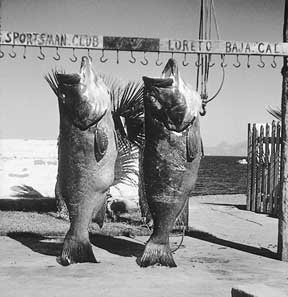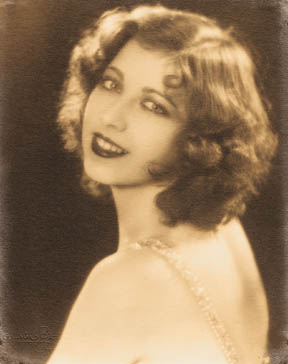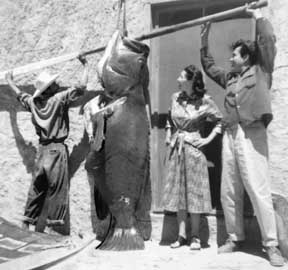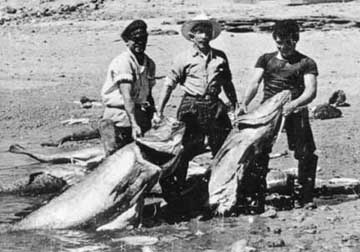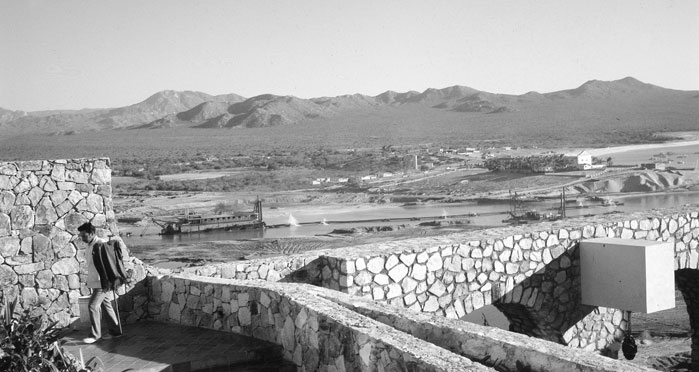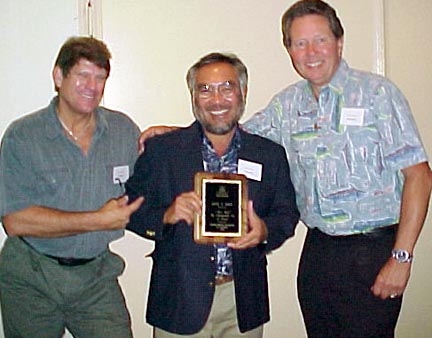
The Unforgettable Sea of Cortez
Baja California's Golden Age 1947-1977
The Life And Writings Of Ray Cannon
By Gene Kira
First Printing 1999; Replica Second Printing 2008.
362 Pages, Hard Cover, 8.5" x 11"
History of Baja California Sport Fishing
A Keepsake, Presentation Quality Volume
Text of More Than 197,000 Words
More Than 400 Historic Baja Photos
$49.95 + Shipping & Sales Tax
|
We are grateful to Tracy and Marco Ehrenberg of Cabo San Lucas, Baja California Sur, Mexico, for making possible this limited edition second printing of The Unforgettable Sea of Cortez. |
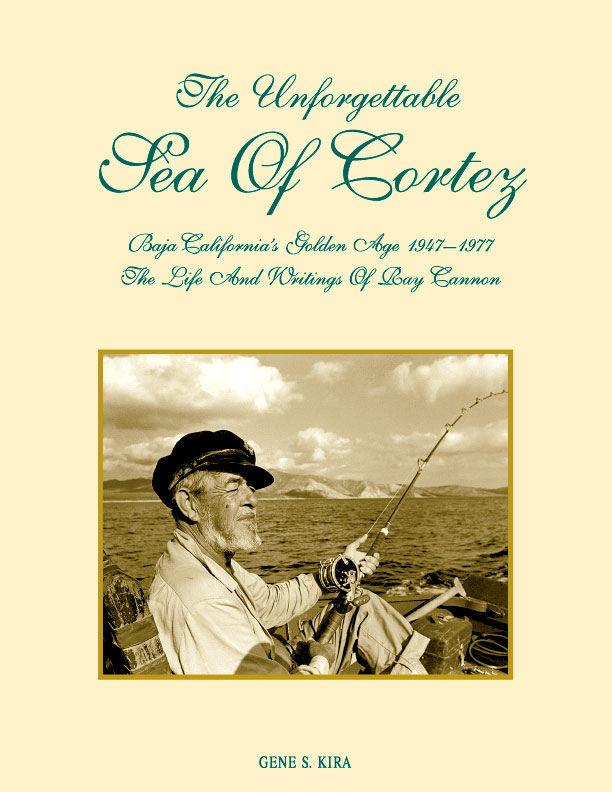
"Best Book Of The Year" -- California Outdoor Writers Association
"A lasting picture of Baja's colorful past." -- Los Angeles Times
"Stunning...the book of the century for Bajaphiles..." -- Fred Hoctor, Western Outdoor News
"Records an important part of the history of Baja California." -- Ricardo Garcia Soto
"Outstanding...readable...Kira has done it again." -- Shirley Miller for Discover Baja
"Encyclopedic...rare...engrossing..." -- San Diego Log
"Beautifully presented...a gem." -- Fred Metcalf
RAY CANNON'S best-selling 1966 book, The Sea Of Cortez, and his 1,000+ sport fishing articles in Western Outdoor News were vital factors in the establishment of modern Baja California from the time of his first Baja trip in 1947 until his death in 1977.
Canon's 30-year career spanned a "Golden Age" for Baja California, a time of miracles and progress, and still unspoiled natural beauty that we can but remember today. And throughout those decades of progress, it was always Ray Cannon--that supremely enthusiastic and jovial rogue of a man--who helped spread the word and made the people of Baja California believe it was all possible.
The Unforgettable Sea Of Cortez is the magical and colorful story of Ray Cannon, the pied piper of Baja California's Golden Age. Here, from his personal archives of thousands of pages and photos, preserved since his death by his lifetime companion, Carla Laemmle, are Ray Cannon's greatest and wildest fish stories. And here is the story of the land he loved, its people, its natural beauty, and its happiest time.
|
Two gigantic fish, either giant black sea bass, or gulf grouper at the limit of their size range, at the Flying Sportsmen Lodge in Loreto. Ray Cannon would eventually come to regret the catching of such fish because of their enormous spawning capability and because of their very slow growth rate which makes them impossible to replace even if all fishing were to stop for half a century. |
GENE AND RAY
By Fred Hoctor, Baja Editor, Western Outdoor News, October 3, 1999.
Reprinted With Permission From Western Outdoor News
Living in Mexico, I am always late getting everything, so it was only a week ago that I finally got my copy of Gene Kira's magnificent new keepsake book about the Sea of Cortez and Ray Cannon, the icon of Baja fishing and the Baja reporter for this paper for 24 years.
The book (The Unforgettable Sea of Cortez) is a treat, Gene Kira is a genius and I am prouder than ever to be trying to walk around in Ray Cannon's shoes, though I know I can never grow into them.
It especially struck me after reading the book that I did not know Ray as well as I thought I did. I don't think anyone could really understand him without seeing the body of his work in retrospect like this, accompanied by reasoned comment and telltale pictures, the way Kira has presented it. In my estimation, the book is not only a monumental tribute to Ray and his lady, Carla Laemmle, it is just as much an unintended tribute to Gene Kira himself, because it took some great doing to get all these fabulous pictures and historical information together, to get it properly sorted out and aligned, and finally to get it all committed to paper.
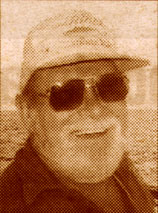 No one who has not gone through the tedious process of birthing a book can really understand the agony of it. To the layman, the gestation and delivery would seem to be painless and easy. In reality, producing a book takes extraordinary vitality and persistence, the willingness and ability to put up with a good deal of self doubt, and the wonderful knack of keeping everything in perspective. It is nearly impossible to invent a new book without personally turning into an amorphous mass of fear and confusion.
No one who has not gone through the tedious process of birthing a book can really understand the agony of it. To the layman, the gestation and delivery would seem to be painless and easy. In reality, producing a book takes extraordinary vitality and persistence, the willingness and ability to put up with a good deal of self doubt, and the wonderful knack of keeping everything in perspective. It is nearly impossible to invent a new book without personally turning into an amorphous mass of fear and confusion.
I am sure that in the course of putting this book together, Kira must have thrown his hands up a dozen times and asked himself if it was really worth it. I know that I can safely speak for every reader when I say that he can be relieved of that uncertainty. The book is a triumph -- at the same time scholarly, utterly fascinating and exactly on the mark.
The pictures are splendid, and I can not imagine how he got them all together. I don't know where he ever found it, but there is one shot of dozens of giant totuava crashing the beach at San Felipe that is worth the whole price of the book.
Ray Cannon was far more than a Hollywood huckster, using a few publicity tricks to promote Baja fishing. His real focus was on Baja itself, and those who called Ray a liar did him a great disservice. He was simply a great showman in the mold of P.T. Barnum, Billy Rose and Mike Todd. He thoroughly believed in his product and, like them, he was shamelessly prone to exaggeration, though he vigorously denied that he ever exaggerated.
Ray, an actor by training, inclination and temperament, took on a lifetime role as a cross between the Hemingway/Bogart character named "Steve," the charter-fishing-boat captain in "To Have and Have Not," and the "old man" of "The Old Man and the Sea." He portrayed himself as the pro's pro when it came to fishing; tough and resourceful, yet full of knowledge, wisdom and sensitivity. He could never quite wear a truly heroic mantle because he was slight of physical stature, but for the wide-eyed crowd of anglers who had never been to Baja, and that included nearly everyone in those days, he pretty well pulled it off. He was such a lovable guy that insiders, who knew just how wild some of his stories were, yet knew how important his work was, begrudged his exaggerations not in the least.
There never was anyone better suited for the job of publicizing Baja and the Sea of Cortez than Ray Cannon. And now we know that there was never anyone better suited to tell the story of Ray's mission than Gene Kira.
If you love Baja, or if you are simply interested only in the lore of fishing, you are remiss if you don't own this book. It is without question the very best Baja book in existence.
|
Carla Laemmle, Universal Studios, c. 1929. |
DEDICATION
The Unforgettable Sea of Cortez is dedicated to Carla Laemmle—born in Chicago, Illinois on October 20, 1909—whose enduring love, faith and courage have brought to life for a second time the story of Ray Cannon and the Golden Age of Baja California.
Carla Laemmle was a young actress and dancer under contract to Universal Studios when she was assigned to a movie to be directed by Raymond Cannon in 1935.
It was the beginning of a remarkable, 42-year partnership that witnessed Ray's rise to fame as the definitive sport fishing writer of Baja California and the author of the best-selling book, The Sea Of Cortez.
Throughout, Carla permitted herself to be known only as "Ray Cannon's secretary," although she was in fact the love of his life, his editor, professional confidant, and the guiding, encouraging spirit that saw him through good times and bad.
For two decades following Ray's death in 1977, Carla carefully preserved every manuscript, letter and photograph from their years together, and it is through her love, faith and dedication that The Unforgettable Sea Of Cortez was made possible.
|
An enormous jewfish caught at Mulege. The fish’s characteristic rounded anal fin has been retouched in the original photo, dated March 16, 1957, but is still discernible.. The Unforgettable Sea of Cortez contains over 400 stunning photos of the early sportfishing in Baja California. |
TABLE OF CONTENTS -- THE UNFORGETTABLE SEA OF CORTEZ
THE LEGACY OF RAY CANNON: Two Messages From The Recent Past
ULISES TILLMAN CANNON: Pied Piper Of Baja California
WINE AND ROSES: The Hollywood Years
LOVE STORY: Ray & Carla & The Sea Of Cortez
SAN FELIPE DISCOVERIES: Ray’s First Trip To Baja
“HOW TO FISH THE PACIFIC COAST”: Ray’s First Hit Book
“WESTERN OUTDOOR NEWS”: Burt Twilegar’s Weekly Magic Carpet
DINNER AT THE LOS ARCOS: Launching The Golden Age
AMAZING MIDRIFF: Early “Panga Motherships”
MAMA & PAPA DIAZ: Pioneers Of Bahia De Los Angeles
RANCHO LAS CRUCES: The First Of The First
GIANT SNOOK OF MULEGE: Ray’s Quest For A World Record
DARING 16-FOOT OUTBOARDS: Birth Of Cortez Small Boat Cruising
GENE PERRY EXPEDITION: Ray’s First Cruise Down The Cortez
RANCHO BUENA VISTA: Ray’s “Home” In Baja
AIRLINE FOR LORETO: Ed Tabor’s Flying Sportsmen Lodge
SOFT-HEARTED RAY: Hunting In Baja
KIDS’ TRIP: Ray’s All-Time Favorite Cruise
“SHIPWRECK CHARLIE” COHEN CRUISE: Serious Learning Experience
INCIDENT AT CHILENO BAY: Serendipity & The “Peggy Sue”
“INTELLIGENT” GOLDEN GROUPER: Ray’s Wildest Baja Yarn
LEGENDS OF THE VAGABUNDOS: Sea Gypsies Of The Cortez
JUANALOA: Naming An Earthly Paradise
GOOD FISHING EVERYWHERE!: Ray’s Greatest “Fish Stories”
DISCOVERING BEAUTIFUL TAMBOBICHE: The Benziger Shipwreck
GREAT DAYS IN BAJA: The Height Of The Golden Age
“THE SEA OF CORTEZ”: Ray’s Bestselling Masterpiece
OTHER EDENS: El Salvador & Puerto Vallarta
VAGABUNDOS DEL MAR CLUB: Down To The Sea In Little Ships
GIANT NEEDLEFISH: The Craziest Thing In The Sea
STORM CLOUDS ON THE HORIZON: Ray’s Lifelong Conservation Efforts
MODERN BAJA: End Of The Golden Age
RAY’S LAST CRUISE: Voyage Of The “Gypsy”
FAREWELL TO A VAGABUNDO: Ray’s Final Trip To Baja
Chapter 25: Hey, I Thought You Brought The Toilet Paper!: An All-Purpose Baja Checklist.
CHRONOLOGY
INDEX
MAP OF BAJA CALIFORNIA DURING THE GOLDEN AGE
|
A commercial catch of enormous totoaba being butchered on the beach at the site of the present day boat launching area of “Papa Fernandez” fish camp on Bahia Willard (just north of Bahia San Luis Gonzaga). From left to right, Tony Reyes Baca, Gorgonio “Papa” Fernandez, and his son, Chi Chi Fernandez, c. 1954. — COURTESY TONY REYES BACA |
THE LEGACY OF RAY CANNON
TWO MESSAGES FROM THE RECENT PAST
From Chapter 1 -- Unforgetttable Sea of Cortez
FOR THE NEWCOMER to Los Cabos and the other tourist centers of Baja California, some of the stories and images in this book may seem to come from another place, or at least from a time quite removed from the present. It might seem logical to assume that the thriving tourist industry of Baja California must have developed over a considerable period, and that many of the curiously quaint photographs and otherworldly fishing stories presented here must be from some epoch of the distant past.
But that is not so. The Unforgettable Sea Of Cortez is about a distinct and very recent period of Baja California history that spanned the years roughly from the end of World War II until the completion of the Transpeninsular Highway in 1973 and the opening of the international airport at San Jose del Cabo in 1977.
During that brief one-third of a century, the people of Baja California brought their desert peninsula from a world of ox carts and sailing canoes firmly into the modern age. Almost every element of Baja California’s modern infrastructure has been created entirely since the end of World War II. This includes the myriad of luxury hotels and resorts, the sport fishing fleets, the international airports, the harbors and ship terminals, the communication systems, the agricultural developments, some of the towns and cities themselves, and all but a single paved highway—from Tijuana to Ensenada.
Those accomplishments brought many benefits to the people of Baja California, but at the cost of a gracious and traditional way of life, also rich in many ways, that was inevitably pushed into history by the pace and pressure of contemporary society.
And, there has been another cost. It may be surprising to the newcomer to learn that most of the “unbelievable fishing stories” contained in this book are actually true. Only a few decades ago, the Sea of Cortez supported a density and richness of life that is almost incomprehensible today.
The writing career of Ray Cannon, the weekly sport fishing columnist for Western Outdoor News, coincided almost perfectly with this era of tremendous economic, social and environmental change; Ray made his first trip to “Baja” in 1947, and he wrote about the peninsula until his death in 1977. In more than a thousand columns and magazine articles from this period, he left us with two important messages:
First, there is the story of the beautiful Golden Age of Baja California—a time of miracles and progress, but in a land still unspoiled and still heavy with the romantic perfume of old Mexico. This was a time when the people of Baja California enjoyed the best of both worlds.
And second, there is the story of how recently rich the Sea of Cortez once was, compared to its present status. In the fantastic descriptions of the chapter, “Good Fishing Everywhere!” and in the strong words of the chapter, “Storm Clouds On The Horizon,” Ray documents the depletion of population after population of fish species—from the California sardine, to the totuava, the yellowtail, the yellowfin tuna, the giant bass and groupers, and many others—and he warns us of how fragile the sea really is.
Ray Cannon—through his charisma, his many articles and his bestselling book, The Sea Of Cortez—did more than any other single person to popularize the early tourist industry of Baja California. But now, as Baja’s modernization becomes a fait accompli in the opening years of the 21st century, Ray’s second message—of our desperate obligation to conserve the beauty and richness of the natural world—emerges as his most lasting legacy.
As the people of Baja California begin to take the first steps toward the restoration and preservation of their magnificent Sea of Cortez, they may perhaps be encouraged by the enthusiastic ghost of Ray Cannon and this vivid reminder of a beautiful past, still alive just beneath the surface of things, that happened only yesterday.
|
The ending of Baja's Golden Age--The dredging of the Cabo San Lucas inner harbor in 1973-1975, here viewed from the Hotel Finisterra, which had opened in 1971. In the newly dug channel, the dredging machine that created the harbor out of a mud flat is seen pumping sand out toward the harbor entrance, and pressurized water can be seen spaying upwards from the pipe leading to the outfall. Across the channel is the original Hotel Hacienda, Cabo San Lucas' first, which was opened in 1963 by Abelardo L. "Rod" Rodriguez. In 1977, the greatly expanded international airport at San Jose del Cabo would open, ushering in the modern era. |
|
The Unforgettable Sea Of Cortez was named Best Book Of The Year by the California Outdoor Writers Association in a presentation held at Oxnard, California, on June 4, 2000. The award was presented to Gene Kira (center) by Bill Karr (left) of Western Outdoor News, who was elected as the association's president for 2000. At right, is the publisher of the book, Mike Bales, of Cortez Publications. |
|
We are grateful to Tracy and Marco Ehrenberg of Cabo San Lucas, Baja California Sur, Mexico, for making possible this limited edition second printing of The Unforgettable Sea of Cortez. |
MEXICO FISHING < THE UNFORGETTABLE SEA OF CORTEZ
